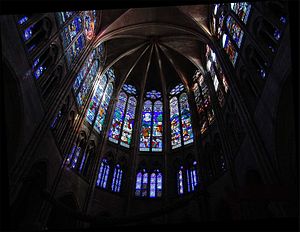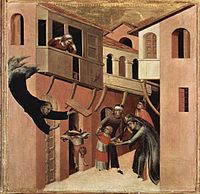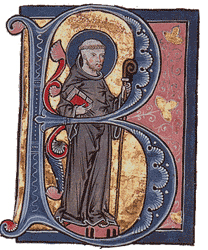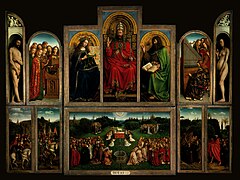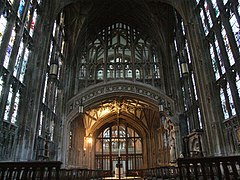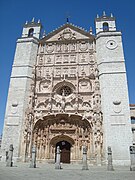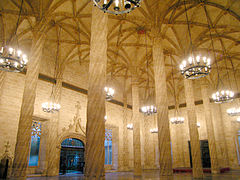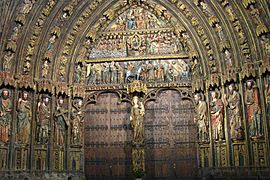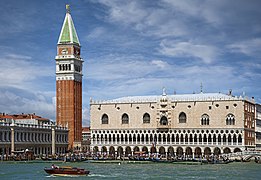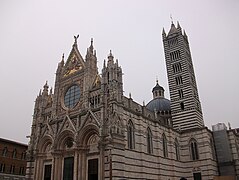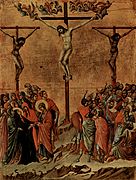Gothic art
Gothic art is the historiographical name for the artistic style that developed in Western Europe during the late Middle Ages, from the middle of the 12th century, with the reformation of Saint Denis Cathedral (1140-1144), until the introduction of the Renaissance (XV for Italy), and well into the XVI century in places where Gothic survived more time. It is a broad artistic period, which arises in the north of France and spreads throughout the West. Depending on the country and region, it develops at different chronological moments, offering in its broad development profound differentiations: purer in France (being quite different from Paris and Provence), more horizontal and close to the classical tradition in Italy (although to the north is one of the most paradigmatic examples, such as the Milan Cathedral), with local peculiarities in Flanders, Germany, England and Spain.
Historical context
Gothic art itself coincides in time with the fullness and crisis of the Middle Ages.
If its predecessor, Romanesque art, reflected a ruralized society of warriors and peasants, Gothic coincides with the resurgence of cities, where the bourgeoisie and universities developed, and with the appearance of new religious orders (monastics such as Cistercians and mendicants like the Franciscans and Dominicans). Conflicts and dissent were also accentuated (popular revolts, heresies, development and crisis of scholasticism, Western Schism); culminating in the terrifying spectacles of the Black Death and the Hundred Years War, a world so changing that it can only be understood in terms of a fundamental mutation (for materialist historiography, the transition from feudalism to capitalism).
Characterization
In contrast to the churches and monasteries of the Romanesque, said this in a general way, the Gothic raises, as its emblematic architectural work, prodigious cathedrals full of light as well as with a great height, these being its main technical contributions, which are They are justified in the writings of Pseudo Dionisio Aeropagita, although an important civil architecture was also developed. Another of its characteristics is that it began to free other plastic arts, such as painting and sculpture, from their subordination to the architectural support.
However, there are also many elements of continuity: this is still a predominantly religious art; The monastery as an institution hardly changed except in formal details and adaptation to new requirements, but its arrangement did not show any changes, and the plan of the churches, mostly cathedrals, continued to be predominantly a Latin cross with an east-facing apse header, although it was complicate or vary (basilica plans, placement of the transept in the center, complication of naves, chapels and ambulatory). Undoubtedly the main element of continuity is the timeless conception of the work: in most of the constructions the styles follow one another and melt to the rhythm of the centuries, contemporaries knowing that they are making a work that they would not see finished, nor perhaps their children or grandchildren, but the construction of these buildings involves the work of several generations. In many of them, the audacity to start a technical or economic challenge is even valued, sometimes due to political rivalry, that when it starts the project has not been fully planned, so it is not known how to complete it, it is the case of the cathedrals of Siena and Florence.
The light
The new religious buildings are characterized by the definition of a space that wants to bring the faithful closer, in an experiential and almost tangible way, to the religious and symbolic values of the time. The incipient humanism freed man from the dark darkness and invited him into the light. This fact is related to the dissemination of Neoplatonic philosophical currents, which establish a link between the concept of God and the realm of light. As the new construction techniques made the walls virtually unnecessary in favor of the openings, the interior of the churches was filled with light, and the light will shape the new Gothic space. It will be a physical light, not figured in paintings and mosaics; general and diffuse light, not concentrated in points and directed as if it were spotlights; at the same time that it is a transfigured and colored light through the play of stained glass windows and rose windows, which transforms the space into an unreal and symbolic one. The color will reach a crucial importance.
Light is understood as the sublimation of divinity. Symbology dominates the artists of the time, the Chartres school considers light the noblest element of natural phenomena, the least material element, the closest approximation to pure form.
The Gothic architect organizes a structure that allows him, through the use of technique, to use light, transfigured light, which dematerializes the elements of the building, achieving clear sensations of elevation and weightlessness.
Gothic architecture
At an architectural level, the Gothic style was born around 1140 in France, the basilica of the royal abbey of Saint Denis (built by Abbot Suger, adviser to Louis VII of France) being considered the first monument of this movement..
Also from the late 12th century and early XIII the monasteries of the Cistercian order spread a style stripped of ornamentation and reduced to the purity of the structural elements, an expression of the aesthetic and spiritual conceptions of Bernardo de Claraval, which was often referred to as Cistercian art.
This art has been defined for a long time in a fairly superficial way exclusively by the use of one of its elements, the pointed arch, which is usually called ogival, from which the ribbed vault is derived that allows the thrusts to be moved to buttresses external, which are further removed from the walls through the use of flying buttresses. This allowed the construction of much larger and higher buildings, and the predominance of openings over the walls. The supporting elements (pillars of complicated design) are much more stylized. But the use of an element cannot define a style globally, it is a broader problem, a new historical stage, a new conception of art and with it the world. A structural element, however important it may be, cannot summarize a global concept of life.
Mainly five fundamental characteristics can be considered in its construction program:
- Targeted arches
- Crossing vaults
- Robots
- Large stained glass windows and rosettes
- Decoration of ornamented stone (statues, columns, capitals, pinnacles or gargolas)
Gothic sculpture
In Gothic sculpture, stone carvings continue to be used to decorate architecture, in addition to fulfilling an evangelizing function (the catechism of the illiterates, the vast majority of the population) but each time it is emancipated more (step from relief to round bulge). Gothic sculpture evolved from a long, rigid style, still partly Romanesque, to a spatial and naturalistic feeling in the late 12th century and early 13th century century. The influence of surviving Greek and Roman sculptures were incorporated into the treatment of fabrics, facial expressions, and pose.
Gothic sculptures were born on the walls of churches in the mid-XII century in the Ile-de-France, when Abbot Suger had the abbey of Saint-Denis built (c. 1140), considered the first Gothic building, and was soon followed by the cathedral of Chartres (c. 1145). Previously, there was no sculptural tradition on the Ile-de-France, so sculptors were brought from Burgundy and they were the ones who created the revolutionary figures that acted as columns in the Royal Portico of Chartres. It was an entirely new invention and would provide the model for a generation of sculptors.
Gothic sculpture spread throughout Western Europe. In Spain the penetration is confirmed through masters and works that came from France; for example, the influence of the Rieux workshop is quite evident in Cardona's Virgin of the Patronage.
The influence of French sculpture spread throughout Germany beginning in 1225 with Bamberg Cathedral, which has the largest collection of sculpture of the century XIII, culminating in 1240 with the Bamberg Horseman (the first equestrian statue in Western art since the VI, and is believed to have portrayed Conrad II).
In England sculpture was more limited to funerary monuments and non-figurative decorations, partly due to Cistercian limitations on the use of images.
In Italy the classical influence still persisted, highlighting works such as the pulpits of the Pisa baptistery (1269) and the Siena cathedral. A late masterpiece of Italian Gothic sculpture is the Arche scaligere in Verona.
Wood carving techniques become increasingly sophisticated, reaching their maximum splendor in the integration of color and the architectural design of highly complex altarpieces. The recovery of the classical tradition of casting bronze will have to wait for the Italian Renaissance.
Dutch sculptor Claus Sluter's taste for naturalism marked the beginning of the end for Gothic sculpture, evolving into Renaissance Classicism at the turn of the century XV.
Gothic painting
It was not until about 1200 that a style of painting that could be called "Gothic" appeared; that is to say, almost 50 years after the beginning of Gothic architecture and sculpture. The transition from Romanesque to Gothic is very imprecise and there is no clear break, but we can see the beginnings of a style that is more somber, dark and emotional than in the previous period. This transition first occurs in England and France around 1200, in Germany around 1220, and Italy around 1300.
It is usual to indicate that, while in Romanesque figurative representations are simplified and idealized, in Gothic realism and naturalism tend to increase, approaching the imitation of nature that will be the ideal of the Renaissance, including the representation of landscapes, which, however, remains unusual.
In the Gothic, in correspondence with the new philosophical and religious trends (recovery of Aristotle's philosophy through Averroism, humanism of Saint Francis of Assisi) the representation of religious characters (saints, angels, the Virgin Mary, Christ) on a plane more human than divine, allowing them to show emotions (pleasure, pain, tenderness, anger), breaking hieraticism and Romanesque formalism.
There are also slow advances in the use of perspective and other technical issues in painting in terms of the treatment of supports (which allow a greater diffusion of mobile art), pigments and binders.
Painting, that is, the representation of images on a surface, during the Gothic period, was practiced in four main techniques:
- Frescos. The mural painting or frescoes continued to be used as the main medium for pictorial narrative on the walls of churches in the South of Europe, as a continuation of previous Christian and Romanesque traditions.
- Glasses. In northern Europe, the stained glass windows were the preferred art until the centuryXV.
- Painting on board. They started in Italy in the centuryXIII and spread throughout Europe, so that for the centuryXV it had become the predominant form, supplanting even the stained glass.
- Miniatures. The illuminated manuscripts represented the most complete documentation of Gothic painting, documenting the existence of a series of styles in places where other monumental works have not survived.
Oil painting on canvas did not become popular until the 15th Centuries and XVI and was the starting point of Renaissance art.
Sumptuary and decorative arts
The decorative arts or sumptuary arts of the Gothic period had a wide development.
The social consideration of art and the artist
The flourishing of the wool and cloth business, linked to the trade fairs and routes that cross Europe from North to South (from Florence, Genoa and Venice to Champagne and Flanders, without forgetting Medina del Campo), produced the birth of of a singular art: tapestry weaving, which had a very important social prestige. Not for their authors, who never went beyond the consideration of mere artisans, but for their owners. Not having a clear separation between the industrial arts and those that today we consider fine arts, the same could be said of master builders, painters and sculptors, who although we keep the names of many of them, did not go beyond also exercising one of the vile trades and mechanics, not even comparable to the liberal professions.
Local Styles
The label International Gothic does not refer to the entire Gothic, but to a particular phase or style of Gothic painting and decorative arts.
The Neo-Gothic
In the 19th century, the romantic enthusiasm for the medieval (as a reaction against academic neoclassicism) and historicism, led to extensive restorations of medieval buildings, reaching the establishment of the neo-Gothic style, architecture made in imitation of medieval Gothic. From this moment on, we dream of a revival of medieval art, filling the term "Gothic" that begins to be clearly distinguished and separated from the Romanesque.
Contenido relacionado
Saint Kitts and Nevis
Politics and government of Saint Lucia
Franc (currency)




